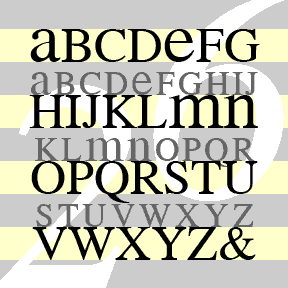MEAN 26 was inspired by Alphabet 26, Bradbury Thompson’s famous 1950 proposal for redesigning the alphabet. The idea was that there would be just one case, favoring the uppercase forms except for a, e, m and n, totaling 26. There would be a large and small version of each to use as capitals.
Thompson used the distinctive Baskerville for his prototype, and Alphabet 26 owes it much of its beauty to that choice. For my fonts, I’ve retooled public-domain versions of 3 popular text fonts and adjusted the weights in an attempt to balance the big and little letters. Avoid the obvious font choice and give your text an unusual feel, rather like large and small caps or Cyrillic.
The Alphabet 26 approach to typesetting does create an unusual texture, but its failure to catch on may be due to the fact that it actually reduces legibility by eliminating the differences between letters. It is nonsense to propose that learning two shapes for each letter is burdensome. The quirky differences between normal lowercase letters, including ascenders and descenders, enable legibility, rather than hinder it. If you want to help reading, work on simplifying spelling.
All 3 fonts contain upper- and lowercase letters, numbers, punctuation, and international characters.


